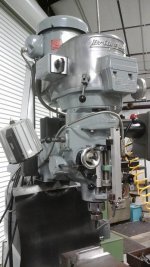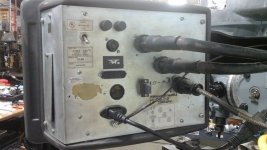M.B. Naegle
Diamond
- Joined
- Feb 7, 2011
- Location
- Conroe, TX USA
We bought a new (to us) Bridgeport to replace one of our worn step-pulley machines. It arrived today and now were eagerly getting it set-up to use. It's a 1990 Series 1 (#BR256274) with the 2HP variable speed head and an Erickson 30 Quick Change spindle. Our old mills are all R8 so we're going through the bittersweet process of upgrading our old tool holders (bitter because we don't have any 30 taper stuff, sweet because it's a better system).
As far as I know, the mill came out of an Aerospace shop in California with a bunch of Bridgeports, and every few years they replace the oldest 4 machines. So it "aged out" but otherwise wasn't in bad shape.
The ways are in much better shape than our old mills. The knee flaking is slightly thin in the mid-front section of the ways, but it hasn't worn through like our old mills. This mill also has a 2003 Prototrak Edge 2 axis control. It won't compete with the machining centers, but it will be so much better than JUST a knee-mill with DRO. I was excited to find out that with the right post, we can import programs from Mastercam. A vast majority of it's work will be simple programs that will be faster to type in at the control, but it will be nice to have the capacity to write more complex 2D programs at the PC.
I'm currently getting everything cleaned up and getting accessories swapped over from the old mill (aprons, work lamp, coolant, etc.)
2 questions:
with the Quick Change spindle, can you just hand tighten the spindle locking nut, or should we use a spanner wrench?
And, Does anyone know the full-load amperage for the Prototrak Edge control? I can't find anything online. The fuses in the back are 1A and 8A but I'm not sure if they are original. The reason I ask is that we typically mount a transformer on the back of our machines (if it doesn't have one built in) to power 110v add-on's like DROs and lamps, so that when you kill power to the machine, a single switch shuts everything off. I just need to know how big a transformer this thing actually needs. In the mean-time, it'll just get plugged into the wall.
Still looking forward to our new VMC in a few months. This mill just settles our nerves in the mean time. Pictures to come.
Pictures to come.
As far as I know, the mill came out of an Aerospace shop in California with a bunch of Bridgeports, and every few years they replace the oldest 4 machines. So it "aged out" but otherwise wasn't in bad shape.
The ways are in much better shape than our old mills. The knee flaking is slightly thin in the mid-front section of the ways, but it hasn't worn through like our old mills. This mill also has a 2003 Prototrak Edge 2 axis control. It won't compete with the machining centers, but it will be so much better than JUST a knee-mill with DRO. I was excited to find out that with the right post, we can import programs from Mastercam. A vast majority of it's work will be simple programs that will be faster to type in at the control, but it will be nice to have the capacity to write more complex 2D programs at the PC.
I'm currently getting everything cleaned up and getting accessories swapped over from the old mill (aprons, work lamp, coolant, etc.)
2 questions:
with the Quick Change spindle, can you just hand tighten the spindle locking nut, or should we use a spanner wrench?
And, Does anyone know the full-load amperage for the Prototrak Edge control? I can't find anything online. The fuses in the back are 1A and 8A but I'm not sure if they are original. The reason I ask is that we typically mount a transformer on the back of our machines (if it doesn't have one built in) to power 110v add-on's like DROs and lamps, so that when you kill power to the machine, a single switch shuts everything off. I just need to know how big a transformer this thing actually needs. In the mean-time, it'll just get plugged into the wall.
Still looking forward to our new VMC in a few months. This mill just settles our nerves in the mean time.
 Pictures to come.
Pictures to come.






